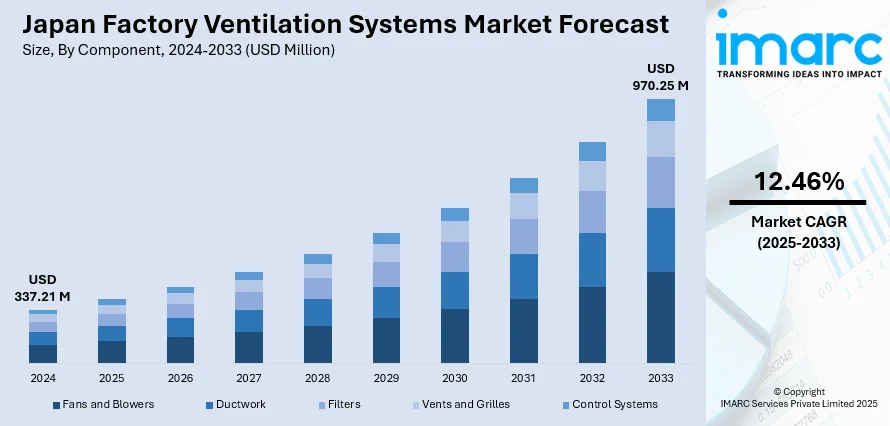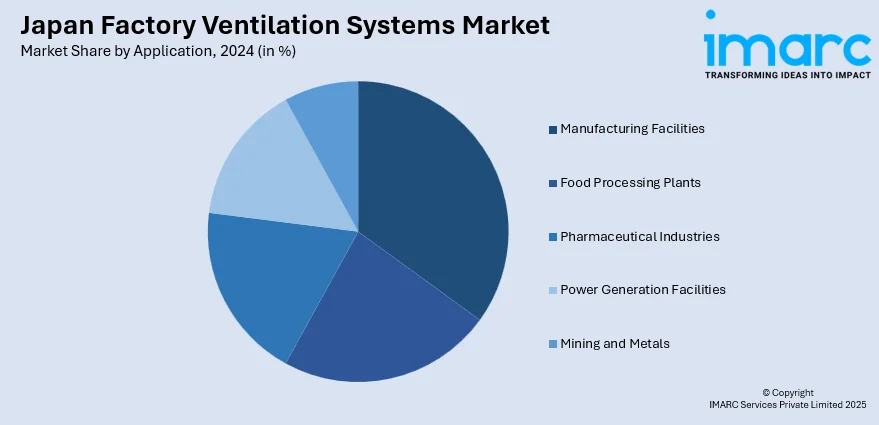
Japan Factory Ventilation Systems Market Size, Share, Trends and Forecast by Component, Type of Ventilation System, Application, End Use Industry, and Region, 2025-2033
Japan Factory Ventilation Systems Market Overview:
The Japan factory ventilation systems market size reached USD 337.21 Million in 2024. Looking forward, IMARC Group expects the market to reach USD 970.25 Million by 2033, exhibiting a growth rate (CAGR) of 12.46% during 2025-2033. The market is driven by stringent environmental policies, such as the Energy Conservation Act and Carbon Neutrality by 2050 mandate, compelling manufacturers to adopt energy-efficient ventilation systems. Rising energy costs and the need for operational efficiency are accelerating demand for IoT-enabled smart ventilation and AI-driven airflow optimization, particularly in high-tech industries. Additionally, advancements in predictive maintenance and 5G-enabled monitoring enhance system reliability, further augmenting the Japan factory ventilation systems market share.
|
Report Attribute
|
Key Statistics
|
|---|---|
|
Base Year
|
2024
|
|
Forecast Years
|
2025-2033
|
|
Historical Years
|
2019-2024
|
| Market Size in 2024 | USD 337.21 Million |
| Market Forecast in 2033 | USD 970.25 Million |
| Market Growth Rate 2025-2033 | 12.46% |
Japan Factory Ventilation Systems Market Trends:
Rising Demand for Energy-Efficient Ventilation Systems
The market is experiencing a growing demand for energy-efficient solutions, driven by stricter environmental regulations and rising energy costs. In 2023, Japan witnessed its total energy consumption fall by 3.5%, at 391 Mtoe, with per capita electricity consumption at 7.3 MWh and energy self-reliance standing at only 16.5%, while it points towards continued dependence on imports and high energy costs. The industrial sector remains the largest electricity user, at 36%, as renewable sources powered the energy supply by 27.5%. These advances highlight the imperative need for energy-efficient factory ventilation technologies to help Japanese manufacturers reduce operating expenses and carbon emissions. The Japanese government has implemented policies such as the Energy Conservation Act and Carbon Neutrality by 2050 initiative, pushing manufacturers to adopt sustainable ventilation technologies. Companies are increasingly investing in demand-controlled ventilation (DCV) systems and heat recovery ventilators (HRVs), which optimize airflow based on real-time occupancy and air quality data. Additionally, advancements in IoT-enabled smart ventilation allow for remote monitoring and energy consumption tracking, further enhancing efficiency. As industries strive to reduce operational costs and carbon footprints, the shift toward high-efficiency motors, low-power fans, and automated ventilation controls is accelerating. This trend is particularly prominent in sectors such as automotive, electronics, and pharmaceuticals, where maintaining clean air standards is critical while minimizing energy use.

Integration of Smart and Automated Ventilation Technologies
The rapid adoption of smart and automated ventilation systems, fueled by Industry 4.0 and smart manufacturing advancements, is favoring the Japan factory ventilation systems market growth. Japan's Society 5.0 vision, moving beyond Industry 4.0, embraces artificial intelligence, the Internet of Things, and robotics to transform key industries including transportation, healthcare, and infrastructure. With smart infrastructure and automation at the center of this digital revolution, factory ventilation systems manufacturers are likely to see increased demand for intelligent, cyber-physical systems. This program also supports Japan's sustainability efforts and alignment with the Sustainable Development Goals, which will be strongly showcased at EXPO 2025 in Osaka. Factories are increasingly deploying AI-driven ventilation systems that use sensors and machine learning to adjust airflow dynamically, improving indoor air quality (IAQ) while reducing energy waste. These systems can detect pollutants, humidity, and temperature changes, automatically optimizing ventilation rates for worker safety and process efficiency. Furthermore, the integration of Building Information Modeling (BIM) and predictive maintenance tools helps prevent system failures, ensuring uninterrupted operations. The growth of 5G and cloud-based analytics has also enhanced real-time data processing, enabling centralized control of multiple facilities. As Japanese manufacturers prioritize worker health and regulatory compliance, the demand for intelligent, self-regulating ventilation solutions is expected to rise significantly, especially in high-tech and precision manufacturing industries.
Japan Factory Ventilation Systems Market Segmentation:
IMARC Group provides an analysis of the key trends in each segment of the market, along with forecasts at the country and regional levels for 2025-2033. Our report has categorized the market based on component, type of ventilation system, application, and end use industry.
Component Insights:
- Fans and Blowers
- Ductwork
- Filters
- Vents and Grilles
- Control Systems
The report has provided a detailed breakup and analysis of the market based on the component. This includes fans and blowers, ductwork, filters, vents and grilles, and control systems.
Type of Ventilation System Insights:
- Natural Ventilation Systems
- Mechanical Ventilation Systems
- Hybrid Ventilation Systems
A detailed breakup and analysis of the market based on the type of ventilation system have also been provided in the report. This includes natural ventilation systems, mechanical ventilation systems, and hybrid ventilation systems.
Application Insights:

- Manufacturing Facilities
- Food Processing Plants
- Pharmaceutical Industries
- Power Generation Facilities
- Mining and Metals
The report has provided a detailed breakup and analysis of the market based on the application. This includes manufacturing facilities, food processing plants, pharmaceutical industries, power generation facilities, and mining and metals.
End Use Industry Insights:
- Manufacturing and Heavy Industries
- Food and Beverage Processing
- Pharmaceuticals and Healthcare
- Electronics and Semiconductor Plants
- Chemical and Petrochemical Industries
- Automotive and Aerospace
- Textiles and Garments
- Others
A detailed breakup and analysis of the market based on the end use industry have also been provided in the report. This includes manufacturing and heavy industries, food and beverage processing, pharmaceuticals and healthcare, electronics and semiconductor plants, chemical and petrochemical industries, automotive and aerospace, textiles and garments, and others.
Regional Insights:
- Kanto Region
- Kansai/Kinki Region
- Central/ Chubu Region
- Kyushu-Okinawa Region
- Tohoku Region
- Chugoku Region
- Hokkaido Region
- Shikoku Region
The report has also provided a comprehensive analysis of all the major regional markets, which include Kanto Region, Kansai/Kinki Region, Central/ Chubu Region, Kyushu-Okinawa Region, Tohoku Region, Chugoku Region, Hokkaido Region, and Shikoku Region.
Competitive Landscape:
The market research report has also provided a comprehensive analysis of the competitive landscape. Competitive analysis such as market structure, key player positioning, top winning strategies, competitive dashboard, and company evaluation quadrant has been covered in the report. Also, detailed profiles of all major companies have been provided.
Japan Factory Ventilation Systems Market News:
- April 01, 2025: Protect Arts Co., Ltd. has released Japan's first ventilation system for shelters, the "AT Barrier 150," on April 1, 2025. Developed in collaboration with Nagoya University, the system is in conformity with CBRNE standards and ensures higher safety using domestically produced high-performance filters. This innovation will enhance shelter ventilation in Japan's industrial and safety industries.
Japan Factory Ventilation Systems Market Report Coverage:
| Report Features | Details |
|---|---|
| Base Year of the Analysis | 2024 |
| Historical Period | 2019-2024 |
| Forecast Period | 2025-2033 |
| Units | Million USD |
| Scope of the Report |
Exploration of Historical Trends and Market Outlook, Industry Catalysts and Challenges, Segment-Wise Historical and Future Market Assessment:
|
| Components Covered | Fans And Blowers, Ductwork, Filters, Vents and Grilles, Control Systems |
| Type of Ventilation Systems Covered | Natural Ventilation Systems, Mechanical Ventilation Systems, Hybrid Ventilation Systems |
| Applications Covered | Manufacturing Facilities, Food Processing Plants, Pharmaceutical Industries, Power Generation Facilities, Mining and Metals |
| End Use Industries Covered | Manufacturing and Heavy Industries, Food and Beverage Processing, Pharmaceuticals and Healthcare, Electronics and Semiconductor Plants, Chemical and Petrochemical Industries, Automotive and Aerospace, Textiles and Garments, Others |
| Regions Covered | Kanto Region, Kansai/Kinki Region, Central/ Chubu Region, Kyushu-Okinawa Region, Tohoku Region, Chugoku Region, Hokkaido Region, Shikoku Region |
| Customization Scope | 10% Free Customization |
| Post-Sale Analyst Support | 10-12 Weeks |
| Delivery Format | PDF and Excel through Email (We can also provide the editable version of the report in PPT/Word format on special request) |
Key Questions Answered in This Report:
- How has the Japan factory ventilation systems market performed so far and how will it perform in the coming years?
- What is the breakup of the Japan factory ventilation systems market on the basis of component?
- What is the breakup of the Japan factory ventilation systems market on the basis of type of ventilation system?
- What is the breakup of the Japan factory ventilation systems market on the basis of application?
- What is the breakup of the Japan factory ventilation systems market on the basis of end use industry?
- What is the breakup of the Japan factory ventilation systems market on the basis of region?
- What are the various stages in the value chain of the Japan factory ventilation systems market?
- What are the key driving factors and challenges in the Japan factory ventilation systems market?
- What is the structure of the Japan factory ventilation systems market and who are the key players?
- What is the degree of competition in the Japan factory ventilation systems market?
Key Benefits for Stakeholders:
- IMARC’s industry report offers a comprehensive quantitative analysis of various market segments, historical and current market trends, market forecasts, and dynamics of the Japan factory ventilation systems market from 2019-2033.
- The research report provides the latest information on the market drivers, challenges, and opportunities in the Japan factory ventilation systems market.
- Porter's five forces analysis assist stakeholders in assessing the impact of new entrants, competitive rivalry, supplier power, buyer power, and the threat of substitution. It helps stakeholders to analyze the level of competition within the Japan factory ventilation systems industry and its attractiveness.
- Competitive landscape allows stakeholders to understand their competitive environment and provides an insight into the current positions of key players in the market.
Need more help?
- Speak to our experienced analysts for insights on the current market scenarios.
- Include additional segments and countries to customize the report as per your requirement.
- Gain an unparalleled competitive advantage in your domain by understanding how to utilize the report and positively impacting your operations and revenue.
- For further assistance, please connect with our analysts.
 Request Customization
Request Customization
 Speak to an Analyst
Speak to an Analyst
 Request Brochure
Request Brochure
 Inquire Before Buying
Inquire Before Buying




.webp)




.webp)












